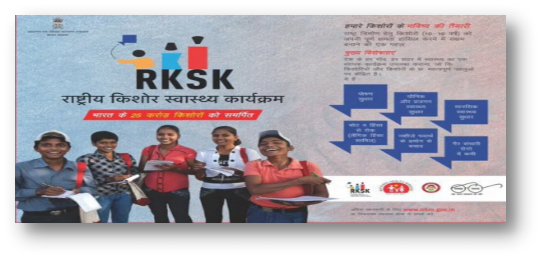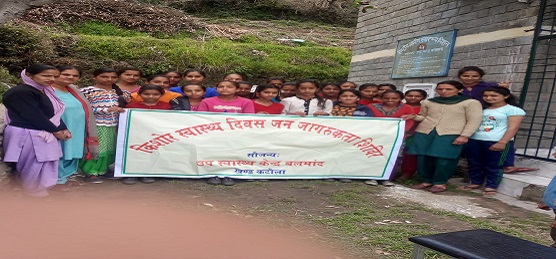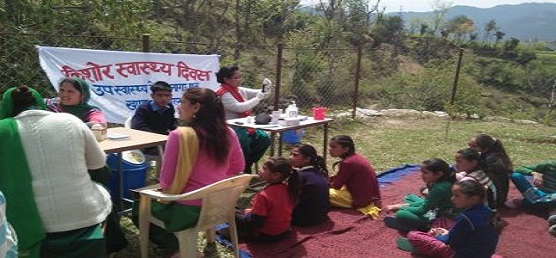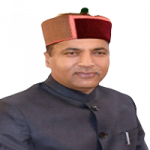Rashtriya Kishor Swasthya Karyakram (RKSK) - Adolescent Health Programme
The Rashtriya Kishor Swasthya Karyakram was launched on 7th January, 2014. The key principle of this programme is adolescent participation and leadership, Equity and inclusion, Gender Equity and strategic partnerships with other sectors and stakeholders. The programme envisions enabling all adolescents in India to realize their full potential by making informed and responsible decisions related to their health and well being and by accessing the services and support they need to do so. There are 253 million adolescents in the age group 10-19 years in India. Out of which our state contributes to 12.8lacs.
They are susceptible to several preventable and treatable health problems, like early & unintended pregnancy, unsafe sex leading to STI/HIV/AIDS, nutritional disorders like malnutrition, anemia & overweight, alcohol, tobacco and drug abuse, mental health concerns, injuries &violence.
Objectives:
- Improve Nutrition
- Improve Sexual and Reproductive Health
- Enhance Mental Health
- Prevent Injuries and violence
- Prevent substance misuse


Components :-
Component 1:
Adolescent Friendly Health Clinics (AFHCs): YUVA SWASTHYA PARAMARSH KENDRA
It provides counseling and curative services at primary, secondary and tertiary levels of care on fixed days and fixed time with due referral linkages. Commodities such as Iron & Folic Acid tablets and non-clinical contraceptives are also made available in the clinics for the adolescents. Counseling services for adolescent on important health areas such as nutrition, puberty, RTI/STI prevention and contraception and delaying marriage and child bearing are being provided through recruitment and training of dedicated counselors.
Component 2:
WIFS: Weekly Iron & Folic Acid Programme:
The Ministry of Health and Family Welfare has launched the Weekly Iron and Folic Acid Supplementation (WIFS) Programme to meet the challenge of high prevalence and incidence of anaemia amongst adolescent girls and boys. It includes supervised weekly ingestion of IFA supplementation and biannual helminthic control. The long term goal is to break the intergenerational cycle of anaemia, the short term benefits is of a nutritionally improved human capital. The programme, implemented across the country both in rural and urban areas.
Target groups:
- School going adolescent girls and boys in 6th to 12th class enrolled in schools.(education department)
- Out of school adolescent girls.(WCD department)
iii. Intervention
Convergence Convergence with key stakeholder ministries like the Ministry of Women and Child Development and Ministry of Human Resource Development is an essential part of implantation plan of the WIFS programme. Key convergent areas include: joint programme planning, capacity building of nodal service providers including Medical Officers, Anganwadi Worker (AWW) Staff Nurses, School teachers, monitoring and a comprehensive communication component.



Component 3:
MENSTRUAL HYGEINE SCHEME:
Background
The Ministry of Health and Family Welfare has been implementing this scheme for promotion of menstrual hygiene among adolescent girls in the age group of 10-19 years primarily in rural areas as part of the Rashtriya Kishor Swasthya Karyakram.
The scheme has the following objectives:
- To increase awareness on menstrual hygiene among adolescent girls
- To increase access to and use of good quality sanitary napkins among adolescent girls residing primarily in rural areas
- To ensure safe disposal of sanitary napkins in an environmentally friendly manner.
The scheme was initially implemented during year 2011 in the 4 districts of the State namely Bilaspur, Hamirpur, Mandi and Una by GOI. In rest of the 8 districts this scheme was implemented in the year 2014. The sanitary napkins were initially distributed by Anganwadi Workers, later this work was given to ASHAs. The ASHAs sold the napkins for Rs. 6 to all the Adolescent girls residing in her area for which she got an incentive @ Rs 1 per pack sold and a free pack of napkins every month for her own personal use. Out of Rs. 5 the ASHA claimed expenses for holding monthly adolescent meetings, transportation and storage of sanitary napkins etc. The left out amount was being deposited by her to the National Health Mission.
In the current financial year a sum of Rs. 3.85 crores has been allocated by GOI for procurement of sanitary napkins. Now as per the budget speech of the Hon’ble Chief Minister of Himachal Pradesh for the year 2018-19 it has been announced that Sanitary napkins which are essential for personal hygiene for adolescent girls shall be provided to all the girls studying in schools up to 10+2 level at the cost of Re. 1 per packet. Provision of Rs. 4 crores has been done in the budget for 2018-19.
INTERDEPARTMENTAL COORDINATION
- Department of Higher Education
- Department of Elementary Education
- Ministry of Women and Child Development
- Ministry of Human Resource Development
- Other organizations like Nehru Yuva Kendra



